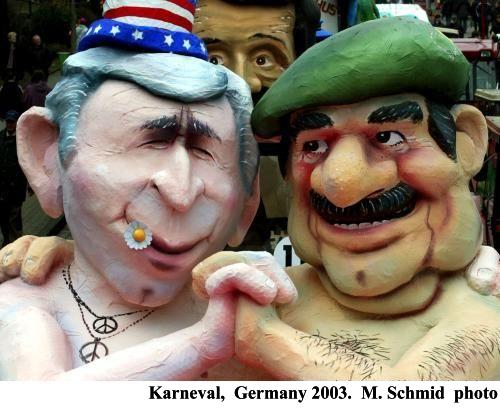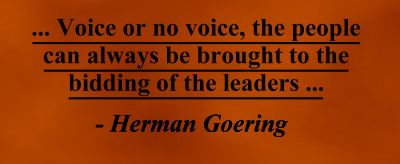
|
zamir-chat-list
|

|
|
|
|
![]() President George Bush, March 17: "Under Resolutions 678 and 687 -- both still in effect -- the U.S. and our allies are authorized to use force in ridding Iraq of weapons of mass destruction.... Last September, I went to the U.N. General Assembly and urged the nations of the world to unite and bring an end to this danger. On November 8th, the Security Council unanimously passed Resolution 1441, finding Iraq in material breach of its obligations, and vowing serious consequences if Iraq did not fully and immediately disarm."
President George Bush, March 17: "Under Resolutions 678 and 687 -- both still in effect -- the U.S. and our allies are authorized to use force in ridding Iraq of weapons of mass destruction.... Last September, I went to the U.N. General Assembly and urged the nations of the world to unite and bring an end to this danger. On November 8th, the Security Council unanimously passed Resolution 1441, finding Iraq in material breach of its obligations, and vowing serious consequences if Iraq did not fully and immediately disarm."
![]() John Negroponte, U.S. Ambassador to the U.N., urging support for Resolution 1441, quoted in Los Angeles Times, November 8, 2002: "There's no 'automaticity' and this is a two-stage process, and in that regard we have met the principal concerns that have been expressed for the resolution." He added: "Whatever violation there is, or is judged to exist, will be dealt with in the [Security] Council, and the Council will have an opportunity to consider the matter before any other action is taken."
Los Angeles Times, Nov. 8 '02
John Negroponte, U.S. Ambassador to the U.N., urging support for Resolution 1441, quoted in Los Angeles Times, November 8, 2002: "There's no 'automaticity' and this is a two-stage process, and in that regard we have met the principal concerns that have been expressed for the resolution." He added: "Whatever violation there is, or is judged to exist, will be dealt with in the [Security] Council, and the Council will have an opportunity to consider the matter before any other action is taken."
Los Angeles Times, Nov. 8 '02

![]() President Bush, March 17: "And it [Saddam Hussein's regime] has aided, trained and harbored terrorists, including operatives of al Qaeda." President Bush, March 6: "He [Saddam Hussein] has trained and financed al Qaeda-type organizations before, al Qaeda and other terrorist organizations." According to several polls, a majority of the U.S. public still believes that there is an Iraq link to 9-11.
President Bush, March 17: "And it [Saddam Hussein's regime] has aided, trained and harbored terrorists, including operatives of al Qaeda." President Bush, March 6: "He [Saddam Hussein] has trained and financed al Qaeda-type organizations before, al Qaeda and other terrorist organizations." According to several polls, a majority of the U.S. public still believes that there is an Iraq link to 9-11.
![]() No evidence establishing such a link has been offered. The New York Times reported on February 9, 2003 that intelligence officials have "pointed out that neither the Bush administration nor the British government, which has also championed the Qaeda-Baghdad connection, has produced direct evidence of Iraqi involvement with the terrorist network." See also: "Allies Find No Links Between Iraq, Al Qaeda," Los Angeles Times, November 4, 2002; "Terrorism experts doubt bin Laden, Baghdad link,"
Toronto Globe and Mail, Feb. 6 '03
No evidence establishing such a link has been offered. The New York Times reported on February 9, 2003 that intelligence officials have "pointed out that neither the Bush administration nor the British government, which has also championed the Qaeda-Baghdad connection, has produced direct evidence of Iraqi involvement with the terrorist network." See also: "Allies Find No Links Between Iraq, Al Qaeda," Los Angeles Times, November 4, 2002; "Terrorism experts doubt bin Laden, Baghdad link,"
Toronto Globe and Mail, Feb. 6 '03
![]() President Bush, March 17: "For more than a decade, the United States and other nations have pursued patient and honorable efforts to disarm the Iraqi regime without war."
President Bush, March 17: "For more than a decade, the United States and other nations have pursued patient and honorable efforts to disarm the Iraqi regime without war."
![]() Resolution 687: Once Iraq complies with the weapons inspection regime, the economic sanctions "shall have no further force or effect." The U.S. government reneged on this, saying that the sanctions would stay in place regardless of compliance with weapons inspectors. May 20, 1991, President George H. W. Bush: "At this juncture, my view is we don't want to lift these sanctions as long as Saddam Hussein is in power."
Institute for Public Accuracy, Mar. 11 '03
Resolution 687: Once Iraq complies with the weapons inspection regime, the economic sanctions "shall have no further force or effect." The U.S. government reneged on this, saying that the sanctions would stay in place regardless of compliance with weapons inspectors. May 20, 1991, President George H. W. Bush: "At this juncture, my view is we don't want to lift these sanctions as long as Saddam Hussein is in power."
Institute for Public Accuracy, Mar. 11 '03
![]() President Bush, March 17: "Intelligence gathered by this and other governments leaves no
doubt that the Iraq regime continues to possess and conceal some of the most lethal weapons
ever devised." State of the Union address, January 28: "The British government has learned that
Saddam Hussein recently sought significant quantities of uranium from Africa."
President Bush, March 17: "Intelligence gathered by this and other governments leaves no
doubt that the Iraq regime continues to possess and conceal some of the most lethal weapons
ever devised." State of the Union address, January 28: "The British government has learned that
Saddam Hussein recently sought significant quantities of uranium from Africa."
![]() The head of the International Atomic Energy Agency (IAEA), Mohamed El Baradei, March
7: "There is no indication of resumed nuclear activities." As reported by the Washington Post
(March 8), the intelligence cited by Bush (as well as Powell before the Security Council) as
proof were forged documents and "the forgers had made relatively crude errors." The Guardian
in London reported on March 8 that "the fabrication was transparently obvious and quickly
established."
The Guardian, UK, Mar. 8, '03
The head of the International Atomic Energy Agency (IAEA), Mohamed El Baradei, March
7: "There is no indication of resumed nuclear activities." As reported by the Washington Post
(March 8), the intelligence cited by Bush (as well as Powell before the Security Council) as
proof were forged documents and "the forgers had made relatively crude errors." The Guardian
in London reported on March 8 that "the fabrication was transparently obvious and quickly
established."
The Guardian, UK, Mar. 8, '03
![]() President Bush, during the State of the Union address, January 28: "Our intelligence sources
tell us that [Hussein] has attempted to purchase high-strength aluminum tubes suitable for
nuclear weapons production."
President Bush, during the State of the Union address, January 28: "Our intelligence sources
tell us that [Hussein] has attempted to purchase high-strength aluminum tubes suitable for
nuclear weapons production."
![]() The Washington Post (March 8) reported that "further work by the IAEA's team of
centrifuge experts -- two Americans, two Britons and a French citizen -- has reinforced
the IAEA's conclusion that the tubes were ill suited for [nuclear weapons production]
centrifuges."
Washington Post, Mar. 7 '03
The Washington Post (March 8) reported that "further work by the IAEA's team of
centrifuge experts -- two Americans, two Britons and a French citizen -- has reinforced
the IAEA's conclusion that the tubes were ill suited for [nuclear weapons production]
centrifuges."
Washington Post, Mar. 7 '03
![]() When Iraq started destroying its Al-Samoud 2 missiles, White House spokesperson Ari Fleischer
claimed on March 3 that Saddam Hussein "denied he had these weapons, and then he destroys
things he says he never had. If he lies about never having them, how can you trust him when he
says he has destroyed them?"
When Iraq started destroying its Al-Samoud 2 missiles, White House spokesperson Ari Fleischer
claimed on March 3 that Saddam Hussein "denied he had these weapons, and then he destroys
things he says he never had. If he lies about never having them, how can you trust him when he
says he has destroyed them?"
![]() In fact, the Iraqi government disclosed these missiles in its December 7, 2002 declaration.
In that same document, "Iraq declared that 13 of the 40 tests of the Al-Samoud 2 had gone
beyond the 93-mile limit." (Associated Press, February 19, 2003)
Tri-City Herald, Feb. 21 '03
In fact, the Iraqi government disclosed these missiles in its December 7, 2002 declaration.
In that same document, "Iraq declared that 13 of the 40 tests of the Al-Samoud 2 had gone
beyond the 93-mile limit." (Associated Press, February 19, 2003)
Tri-City Herald, Feb. 21 '03
![]()
 On many occasions, the administration cited the testimony of Iraqi defector Lt. Gen. Hussein
Kamel as evidence that Iraq was still hiding weapons of mass destruction. For example, on
October 7, 2002, Bush stated: "In 1995 ... the head of Iraq's military industries defected. It was
then that the regime was forced to admit that it had produced more than 30,000 liters of anthrax
and other deadly biological agents.... This is a massive stockpile of biological weapons that has
never been accounted for."
On many occasions, the administration cited the testimony of Iraqi defector Lt. Gen. Hussein
Kamel as evidence that Iraq was still hiding weapons of mass destruction. For example, on
October 7, 2002, Bush stated: "In 1995 ... the head of Iraq's military industries defected. It was
then that the regime was forced to admit that it had produced more than 30,000 liters of anthrax
and other deadly biological agents.... This is a massive stockpile of biological weapons that has
never been accounted for."
![]() According to UNSCOM/IAEA documents, the same defector had also told U.N. inspectors
that Iraq had destroyed its entire stockpile of chemical and biological weapons and banned
missiles. According to a Newsweek story on February 24 ("The Defector's Secrets"), Kamel also
told his story to the CIA and MI6. A military aide who defected with Kamel "backed Kamel's
assertions about the destruction of WMD stocks."
MSNBC, FAIR, Feb. 27 '03
According to UNSCOM/IAEA documents, the same defector had also told U.N. inspectors
that Iraq had destroyed its entire stockpile of chemical and biological weapons and banned
missiles. According to a Newsweek story on February 24 ("The Defector's Secrets"), Kamel also
told his story to the CIA and MI6. A military aide who defected with Kamel "backed Kamel's
assertions about the destruction of WMD stocks."
MSNBC, FAIR, Feb. 27 '03
From a posting to the act-ma list, Tue, 18 Mar 2003
Material collected by the Institute for Public Accuracy
![]()